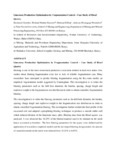| dc.description.abstract | Blasting is one of the most economical production excavation method in hard rock mines. Few
studies about blasting fragmentation exist due to lack of reliable fragmentation data. Many
researchers have attempted to predict blasting fragmentation using the Kuz-rams model, an
empirical fragmentation model suggested by Cunningham. This investigation is to relate the
blasting parameters such as the drill hole diameter, the burden, spacing, charge length and
explosive weight to the fragmentation size distribution in order to obtain controlled fragmentation
blasting.
This investigation is to relate the blasting parameters such as the drill hole diameter, the burden,
spacing, charge length and explosive weight to the fragmentation size distribution in order to
obtain controlled fragmentation blasting. The investigation further studied the final profile of the
excavated wall and adopted a presplitting blasting techniques to produce a smooth stable wall
which reduced dilution of the limestone muck piles. Blasting data from the Bissel quarry was
analyzed. It was observed that 16.25% of the blasted material used to be retained on the mesh
hence accounted as boulders. The best blasting parameters for the quarry were defined and by
application of researchers empirical models and the developed blasting design model, the amount
of material retained on the mesh were reduced from 16.25% to 0.65%. | en_US |

